Donate now to support the LLIFLE projects.
Your support is critical to our success.
Your support is critical to our success.
Strombocactus schmiedickeanus var. klinkerianus
Repert. Pl. Succ. 1972: 10. 1974 (as "var. klinkeranus")
Family: CACTACEAE
Repert. Pl. Succ. 1972: 10. 1974 (as "var. klinkeranus")
Family: CACTACEAE
Accepted Scientific Name: Turbinicarpus schmiedickeanus subs. klinkerianus (Backeb. & H.Jacobsen) N.P.Taylor
Cactaceae Consensus Init. 5: 14. 1998 - Remarks: Panarotto (in Piante Grasse, 18(3): 120. 1998 (1999)) also published this comb. nov. (isonym)
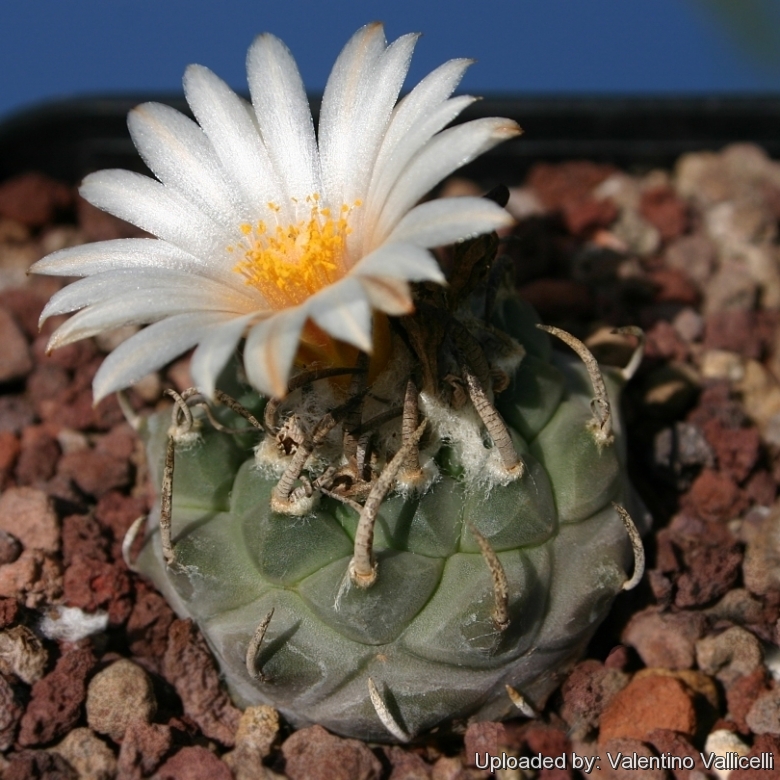
Strombocactus schmiedickeanus var. klinkerianus (Turbinicarpus schmiedickeanus subs. klinkerianus) Photo by: Valentino Vallicelli
This species has 3 spines the lower one longer, up to 1 cm, the 2 upper ones small only on young areoles, flattened below, curved towards the apex, grey with dark tip, corky, rather soft, with transverse fissures.
This species has 3 spines the lower one longer, up to 1 cm, the 2 upper ones small only on young areoles, flattened below, curved towards the apex, grey with dark tip, corky, rather soft, with transverse fissures.
Synonyms:
- Turbinicarpus schmiedickeanus subs. klinkerianus (Backeb. & H.Jacobsen) N.P.Taylor
- Neolloydia schmiedickeana var. klinkeriana (Backeb. & H.Jacobsen) E.F.Anderson
- Pediocactus schmiedickeanus var. klinkerianus (Backeb. & H.Jacobsen) Halda
- Strombocactus klinkerianus (Backeb. & H.Jacobsen) Buining
- Strombocactus schmiedickeanus var. klinkerianus (Backeb. & H.Jacobsen) G.D.Rowley
- Toumeya klinkeriana (Backeb. & H.Jacobsen) Bravo & W.T.Marshall
- Toumeya schmiedickeana var. klinkeriana (Backeb. & H.Jacobsen) Krainz
- Toumeya schmiedickeanus var. klinkerianus (Backeb. & H.Jacobsen) Glass & R.A.Foster
- Turbinicarpus klinkerianus Backeb. & H.Jacobsen
- Turbinicarpus macrochele subs. klinkerianus (Backeb. & H.Jacobsen) Doweld
- Turbinicarpus schmiedickeanus var. klinkerianus (Backeb. & H.Jacobsen) Glass & R.A.Foster
See all synonyms of Turbinicarpus schmiedickeanus
back
Accepted name in llifle Database:Turbinicarpus schmiedickeanus (Boed.) Buxb. & Backeb.
Cactaceae (Berlin) 1937(1): Blatt 27. [25 Mai 1937] et: Jahrb. Deutsch. Kakteen-Ges. 1937, 1st Teil, 27.
Synonymy: 11
- Turbinicarpus schmiedickeanus (Boed.) Buxb. & Backeb.
- Echinocactus schmiedickeanus Boed.
- Neolloydia schmiedickeana (Boed.) E.F.Anderson
- Pediocactus schmiedickeanus (Boed.) Halda
- Strombocactus schmiedickeanus (Boed.) J.West
- Toumeya schmiedickeana (Boed.) W.T.Marshall
- Turbinicarpus schmiedickeanus var. alenae Halda & Kupčák
- Turbinicarpus schmiedickeanus f. aurata hort.
- Turbinicarpus schmiedickeanus f. cristatus hort.
- Turbinicarpus sp. Santa Rita n.n.
Turbinicarpus schmiedickeanus subs. andersonii Mosco & Zanov.
Cactaceae Consensus Init. 7: 18. 1999
Synonymy: 5
- Turbinicarpus schmiedickeanus subs. andersonii Mosco & Zanov.
- Turbinicarpus andersonii (Mosco & Zanov.) D.Donati
- Turbinicarpus macrochele subs. andersonii (Mosco & Zanov.) Doweld
- Turbinicarpus schmiedickeanus subs. panarottoi (Říha) Lüthy
- Turbinicarpus schmiedickeanus var. panarottoi Říha
Turbinicarpus schmiedickeanus subs. bonatzii (G.Frank) Panar.
Piante Grasse 18(3): 120. 1999 [1998 publ. 1999]
Synonymy: 3
- Turbinicarpus schmiedickeanus subs. bonatzii (G.Frank) Panar.
- Pediocactus bonatzii (G.Frank) Halda
- Turbinicarpus bonatzii G.Frank
Turbinicarpus schmiedickeanus subs. dickisoniae (Glass & R.A.Foster) N.P.Taylor
Cactaceae Consensus Init. 5: 14. 1998
Synonymy: 6
- Turbinicarpus schmiedickeanus subs. dickisoniae (Glass & R.A.Foster) N.P.Taylor
- Neolloydia schmiedickeana var. dickisoniae (Glass & R.A.Foster) E.F.Anderson
- Pediocactus schmiedickeanus var. dickisoniae (Glass & R.A.Foster) Halda
- Turbinicarpus dickisoniae Glass & A.Hofer in Glass
- Turbinicarpus gracilis subs. dickisoniae (Glass & R.A.Foster) Panar.
- Turbinicarpus schmiedickeanus var. dickisoniae Glass & R.A.Foster
Turbinicarpus schmiedickeanus subs. flaviflorus (G.Frank & A.B.Lau) Glass
Guía Identif. Cact. Amenazadas México 1: Tu/sch ssp. flaviflorus (1998 publ. 1997)
Synonymy: 7
- Turbinicarpus schmiedickeanus subs. flaviflorus (G.Frank & A.B.Lau) Glass
- Neolloydia schmiedickeana var. flaviflora (G.Frank & A.B.Lau) E.F.Anderson
- Pediocactus schmiedickeanus var. flaviflorus (G.Frank & A.B.Lau) Halda
- Turbinicarpus flaviflorus G.Frank & A.B.Lau
- Turbinicarpus macrochele subs. flaviflorus (G.Frank & A.B.Lau) Doweld
- Turbinicarpus schmiedickeana var. flaviflora (G.Frank & A.B.Lau) E.F.Anderson
- Turbinicarpus schmiedickeanus var. flaviflorus (G.Frank & A.B.Lau) Glass & R.A.Foster
Turbinicarpus schmiedickeanus subs. flaviflorus f. brevispinus
Synonymy: 5
- Turbinicarpus schmiedickeanus subs. flaviflorus f. brevispinus
- Turbinicarpus flaviflorus f. brevispinus
- Turbinicarpus flaviflorus forma brevispina hort.
- Turbinicarpus flaviflorus forma inermis hort.
- Turbinicarpus flaviflorus f. inermis
Turbinicarpus schmiedickeanus subs. gracilis (Glass & R.A.Foster) Glass
Guía Identif. Cact. Amenazadas México 1: Tu/sch ssp. gracilis (1998 publ. 1997)
Synonymy: 5
- Turbinicarpus schmiedickeanus subs. gracilis (Glass & R.A.Foster) Glass
- Neolloydia schmiedickeana var. gracilis (Glass & R.A.Foster) E.F.Anderson
- Pediocactus schmiedickeanus var. gracilis (Glass & R.A.Foster) Halda
- Turbinicarpus gracilis Glass & R.A.Foster
- Turbinicarpus schmiedickeanus var. gracilis (Glass & R.A.Foster) Glass & R.A.Foster
Turbinicarpus schmiedickeanus subs. gracilis f. cristatus hort.
"forma cristata"
Synonymy: 3 Accepted name in llifle Database:
Turbinicarpus schmiedickeanus subs. klinkerianus (Backeb. & H.Jacobsen) N.P.Taylor
Cactaceae Consensus Init. 5: 14. 1998 - Remarks: Panarotto (in Piante Grasse, 18(3): 120. 1998 (1999)) also published this comb. nov. (isonym)
Synonymy: 22
- Turbinicarpus schmiedickeanus subs. klinkerianus (Backeb. & H.Jacobsen) N.P.Taylor
- Neolloydia schmiedickeana var. klinkeriana (Backeb. & H.Jacobsen) E.F.Anderson
- Pediocactus schmiedickeanus var. klinkerianus (Backeb. & H.Jacobsen) Halda
- Strombocactus klinkerianus (Backeb. & H.Jacobsen) Buining
- Strombocactus schmiedickeanus var. klinkerianus (Backeb. & H.Jacobsen) G.D.Rowley
- Toumeya klinkeriana (Backeb. & H.Jacobsen) Bravo & W.T.Marshall
- Toumeya schmiedickeana var. klinkeriana (Backeb. & H.Jacobsen) Krainz
- Toumeya schmiedickeanus var. klinkerianus (Backeb. & H.Jacobsen) Glass & R.A.Foster
- Turbinicarpus klinkerianus Backeb. & H.Jacobsen
- Turbinicarpus macrochele subs. klinkerianus (Backeb. & H.Jacobsen) Doweld
- Turbinicarpus schmiedickeanus var. klinkerianus (Backeb. & H.Jacobsen) Glass & R.A.Foster
- Turbinicarpus klinkerianus subs. hiemalis D.Donati & Zanov.
- Turbinicarpus klinkerianus subs. planiziei D.Donati & Zanov.
- Turbinicarpus schmiedickeanus subs. klinkerianus f. aurata hort.
- Turbinicarpus schmiedickeanus subs. klinkerianus var. lilnkeuiduus
- Turbinicarpus schmiedickeanus subs. klinkerianus f. pachystele
- Turbinicarpus sp. Negrita
Turbinicarpus schmiedickeanus subs. klinkerianus f. cristatus hort.
Accepted name in llifle Database:
Turbinicarpus schmiedickeanus var. kupcakii (Halda & Horáček) Halda & Horáček
Acta Mus. Richnov., Sect. Nat. 9(1): 78. 2002
Synonymy: 2
- Turbinicarpus schmiedickeanus var. kupcakii (Halda & Horáček) Halda & Horáček
- Turbinicarpus macrochele subs. kupcakii Halda & Horáček
Turbinicarpus schmiedickeanus subs. macrochele (Werderm.) N.P.Taylor
Cactaceae Consensus Init. 5: 14. 1998 [see also: Panar.
Synonymy: 12
- Turbinicarpus schmiedickeanus subs. macrochele (Werderm.) N.P.Taylor
- Echinocactus macrochele Werderm.
- Neolloydia schmiedickeana var. macrochele (Werderm.) E.F.Anderson
- Pediocactus schmiedickeanus var. macrochele (Werderm.) Halda
- Strombocactus macrochele (Werderm.) Backeb.
- Toumeya macrochele (Werderm.) W.T.Marshall
- Turbinicarpus macrochele (Werderm.) Buxb. & Backeb.
- Turbinicarpus schmiedickeanus var. macrochele (Werderm.) Glass & R.A.Foster
- Turbinicarpus macrochele subs. frailensis P.Lechner & Jantschgi
- Turbinicarpus macrochele subs. valteri D.Donati & Zanov.
- Turbinicarpus schmiedickeanus subs. macrochele f. cristatus hort.
Turbinicarpus schmiedickeanus var. polaskii (Backeb.) M.Zachar, Stanik, Lux & Dráb
Rod Turbinicarpus (Genus Turbinicarpus) 47 (1996), basionym not validly publ.
Synonymy: 9
- Turbinicarpus schmiedickeanus var. polaskii (Backeb.) M.Zachar, Stanik, Lux & Dráb
- Strombocactus polaskii (Backeb.) T.Hewitt
- Toumeya macrochele f. polaskii (Backeb.) Kladiwa
- Toumeya schwarzii var. polaskii (Backeb.) Kladiwa
- Turbinicarpus macrochele subs. polaskii (P.Lechner & Jantschgi) D.Donati
- Turbinicarpus macrochele var. polaskii P.Lechner & Jantschgi
- Turbinicarpus polaskii Backeb.
- Turbinicarpus schmiedickeanus var. polaskii f. variegatus hort.
Turbinicarpus schmiedickeanus subs. schwarzii (Shurly) N.P.Taylor
Cactaceae Consensus Init. 5: 14. 1998
Synonymy: 15
- Turbinicarpus schmiedickeanus subs. schwarzii (Shurly) N.P.Taylor
- Neolloydia schmiedickeana var. schwarzii (Shurly) E.F.Anderson
- Pediocactus schmiedickeanus var. schwarzii (Shurly) Halda
- Strombocactus schwarzii Shurly
- Thelocactus macrochele var. schwarzii (Shurly) Kladiwa
- Turbinicarpus klinkerianus subs. schwarzii (Shurly) D.Donati
- Turbinicarpus macrochele subs. schwarzii (Shurly) Doweld
- Turbinicarpus schmiedickeanus var. schwarzii (Shurly) Glass & R.A.Foster
- Turbinicarpus schmiedickeanus f. schwarzii (Shurly) Panar.
- Turbinicarpus schwarzii (Shurly) Backeb.
- Turbinicarpus ellisiae Halda, Kupčák & Panar.
- Turbinicarpus schmiedickeanus subs. rubriflorus (G.Frank) Panar.
- Pediocactus schmiedickeanus var. rubriflorus (G.Frank) Halda
- Turbinicarpus schmiedickeanus var. rubriflorus (G.Frank) M.Zachar
- Turbinicarpus schwarzii var. rubriflorus G.Frank
back
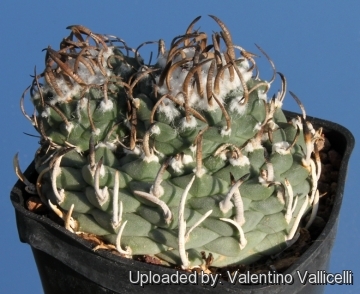
It exhibits some diversity regarding the shape and size of the spines, sometimes quite long and curl over top of plant. (Turbinicarpus schmiedickeanus subs. klinkerianus) Photo by: Valentino Vallicelli
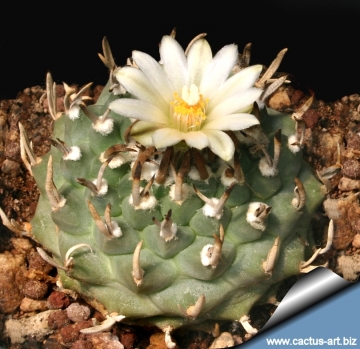
Strombocactus schmiedickeanus var. klinkerianus (Turbinicarpus schmiedickeanus subs. klinkerianus) Photo by: Cactus Art
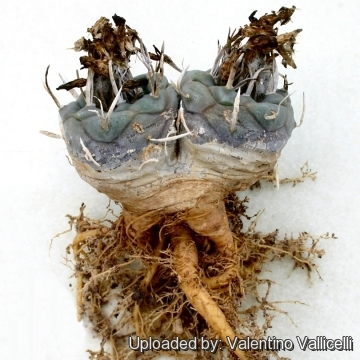
Strombocactus schmiedickeanus var. klinkerianus (Turbinicarpus schmiedickeanus subs. klinkerianus) Photo by: Valentino Vallicelli
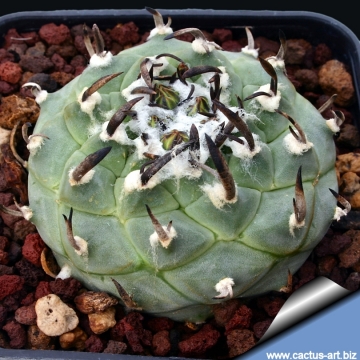
Strombocactus schmiedickeanus var. klinkerianus (Turbinicarpus schmiedickeanus subs. klinkerianus) Photo by: Cactus Art
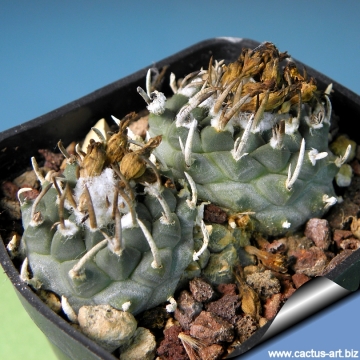
Strombocactus schmiedickeanus var. klinkerianus (Turbinicarpus schmiedickeanus subs. klinkerianus) Photo by: Cactus Art
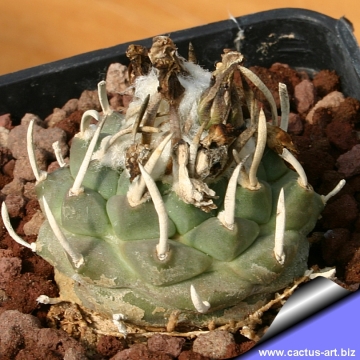
Strombocactus schmiedickeanus var. klinkerianus (Turbinicarpus schmiedickeanus subs. klinkerianus) Photo by: Cactus Art
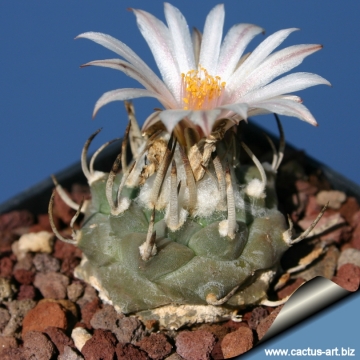
Strombocactus schmiedickeanus var. klinkerianus (Turbinicarpus schmiedickeanus subs. klinkerianus) Photo by: Cactus Art
Send a photo of this plant.
The gallery now contains thousands of pictures, however it is possible to do even more. We are, of course, seeking photos of species not yet shown in the gallery but not only that, we are also looking for better pictures than those already present. Read More...
The gallery now contains thousands of pictures, however it is possible to do even more. We are, of course, seeking photos of species not yet shown in the gallery but not only that, we are also looking for better pictures than those already present. Read More...
| Your Actions | |
|---|---|
| Back to Strombocactus index | |
| Back to Cactaceae index | |
 |
Back to Cacti Encyclopedia index |








